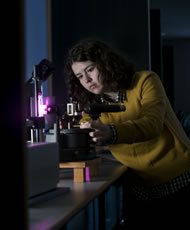Madalina Mironiuc MPhys Physics with Nanotechnology, 2020
Colour Holographic Ltd

Madalina’s SEPnet placement at Colour Holographic Ltd in London involved writing algorithms to test the brightness of holograms, as well as working in the company’s laboratories to investigate how to integrate a hologram in a VR system.
It’s a great opportunity to see how the skills you learn for your degree translate to working for a company, develop new professional relationships and be exposed to innovative ideas.
Why did you decide to do a placement?
I enjoy practical physics and I was curious about what jobs a physicist might do. You hear people saying they work in industry or on a research project, but what I wasn’t sure what that meant, exactly. I wanted to see for myself what my future job might look like. In addition, I wanted to spend my summer applying and broadening the physics concepts that I learned in the previous academic year. I received an email from the South East Physics Network (SEPnet) advertising summer placement opportunities, so I applied for the one at Colour Holographic Ltd - and was really pleased to get it!
How would you describe a typical day?
Most days I would go to work at 10am and, for most of the morning, I would work on the code I was writing for testing the brightness of a thick hologram. This involved writing the code, checking it for mistakes and then, by integrating it in the optical software, I would test if the output was consistent with what we expected for a particular hologram. After lunch, I would go downstairs into one of the labs to use the open-source eye-tracking software to investigate the best setup for integrating a hologram in a VR system.
When I saw the holograms made by Colour Holographic in real-life I was completely by fascinated them. I remember my co-workers showing me a hologram of a revolver and for a moment I thought I could grab it – the amount of detail you could see was amazing. I think it is really interesting because we basically store information in the interference of light – it’s similar to a photograph but in 3D and so much more detailed.
How do you think the placement has benefitted you?
As I was working on two projects, I was able to develop my coding skills by writing the algorithm that would test the brightness of the hologram, as well as my practical skills by working in the laboratory.
I also improved my problem solving skills as I tried to find solutions myself wherever I could. I was exposed to lots of new ideas, and challenged to find ways to implement or improve them. But if I ever needed to ask for help, it wasn’t a problem – my co-workers were always there to offer assistance!
Would you recommend doing a placement to other students?
Yes, I would! It’s a great opportunity to see how the skills you learn for your degree translate to working for a company, develop new professional relationships and be exposed to innovative ideas.
When I explained to one of the co-founders of the company that I really like practical physics, he suggested I contact Pearl John, an academic in the Physics and Astronomy department. Pearl does a lot of work with holograms. Since my placement I’ve been assisting Pearl with one of her projects, alongside my studies. We’re testing how we can make holograms without the need for sophisticated equipment.
SEPnet placements are made available from February every year. For more information please contact Michelle Limbert, SEPnet Engagement Officer, at m.limbert@soton.ac.uk